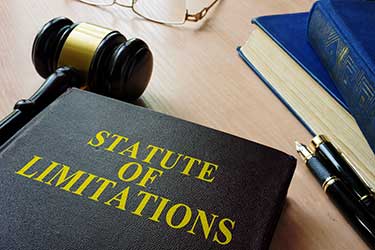The Code of Civil Procedure, Sect. 335.1 sets forth the statute of limitations for bringing a wrongful death suit in California as two years from the date of injury or death.
This is the case with most wrongful death claims, but there are several other situations where a different statute of limitations could apply.
Wrongful Death Statute of Limitations in California
In addition to the standard two-year cut off from the date of injury or death, there are two other scenarios that may apply to wrongful death claims in California. The first involves medical malpractice, or health care provider negligence.
In these matters, the California wrongful death statute of limitations is either three years from the date of injury; or one year after the plaintiff discovers the problem or should have discovered the injury — whichever comes first.
If the wrongful death claim is based on government tort liability, like a motor vehicle accident with a county or city vehicle, then any claim against the government must be filed within six months of the injury.
What is the California Wrongful Death Statute?

Under the California statute, there is a wrongful death if the following elements are present:
- Negligence or wrongful act
- Resulting death
- Damages, consisting of pecuniary loss sustained by the heirs
This law allows certain people to bring a claim for compensation for their financial losses that resulted from someone else’s untimely death.
It is a civil lawsuit and it can be brought against the person or people who were responsible for the person’s death.
Who Can Bring a Wrongful Death Claim?
Under the California wrongful death statute, only certain people can lawfully bring a claim for wrongful death.
Some of these include:
- Surviving spouse if married at the time of death
- Children of the deceased
- Surviving registered domestic partner
If the deceased did not have any of the aforementioned relatives, then an heir could be anyone who would be entitled to the deceased’s property, as if he or she died intestate (without a will).
If there were other people who were dependent on the deceased, like a putative spouse or the putative spouse’s children, or parents or stepparents of the deceased, they could also be eligible to file in this situation.
Additionally, any minor, provided they resided with the deceased for at least 180 days and were financially dependent on the deceased for at least 50 percent of their support.
If there are multiple claimants to a wrongful death claim, they must be joined together in one single court action. There cannot be multiple claims filed against the responsible party.
California follows the “one action rule,” which means all claimants must be on one lawsuit.
There is a good reason for this rule, which protects the defendant from defense costs on more than one lawsuit, and it helps prevent an inconsistent ruling resulting from having more than one case.
Claimants who are not joined on the original wrongful death lawsuit could be barred from bringing their own action against the responsible person or party.
This would be unfair, which is why the heirs have a mandatory responsibility to include any known heirs.
If an heir intentionally leaves off a claimant, the heir may be responsible to the other claimant.
Types of Compensation in a California Wrongful Death Claim
Plaintiffs who bring a wrongful death action on behalf of a loved one seek compensation for a variety of damages. Some of the more common ones include:
- Medical expenses and vehicle damages (pursued under survival action)
- Burial and funeral expenses
- Loss of companionship
- Loss of financial support
- Other economic losses
- Emotional distress of parent or sibling who witnessed the incident
- Out of pocket expenses
Valuing a Wrongful Death Claim
Putting a value on certain aspects of wrongful death can be extremely complex. It is not easy to determine how deep the expected loss of financial support might run, sexual relationship, or supposal support around the household services.
There needs to be an analysis of the person’s past and future expected earnings, his or her employment background, capabilities, and special talents, as well as determining the needs of surviving heirs.
Proving life expectancy can be difficult and may require the expertise of an expert who can consider important factors like the person’s age, activities, health, lifestyle, past medical problems, current health habits and exercise, and other related information.
Determining a monetary value regarding the loss of care, comfort, and moral support by the heirs is a sensitive area.
This is why it’s important to retain a California wrongful death attorney who specializes in these matters.
Only an attorney who has ample experience evaluating wrongful death claims can present a figure to the other side that is quantifiable but also takes the emotional aspects into account.
Beat California’s Wrongful Death Statute of Limitations
If you’ve lost a loved one in a wrongful death accident, call the Beliz Law Firm for a complimentary consultation. Our team can help you understand all the elements of the California wrongful death statutes and whether or not you have a valid claim. Contact us today.
